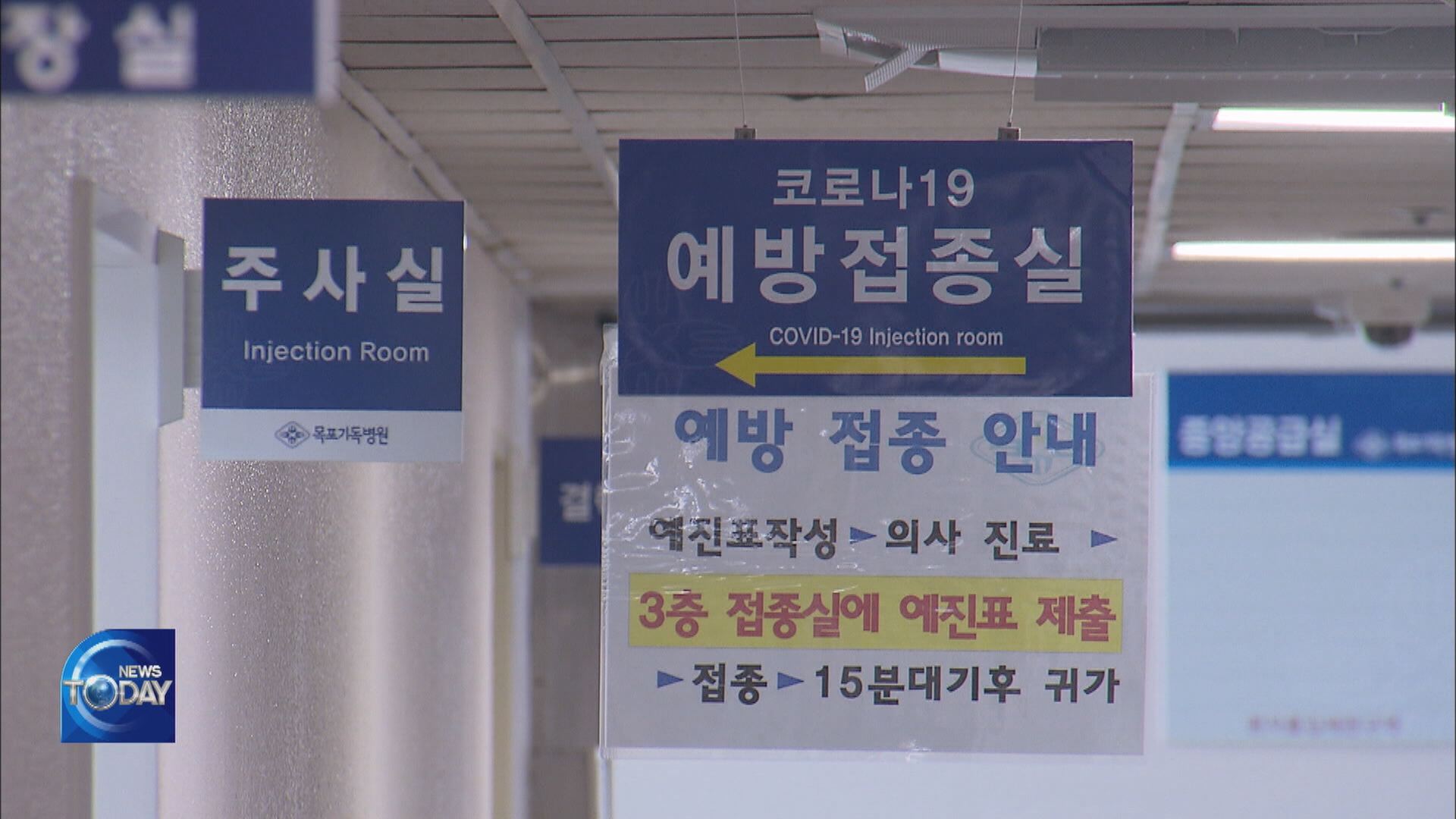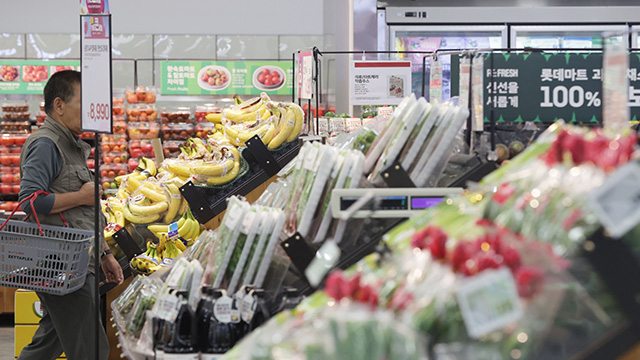INCREASE IN CONSUMER PRICES
입력 2021.10.07 (15:19)
수정 2021.10.07 (16:46)
읽어주기 기능은 크롬기반의
브라우저에서만 사용하실 수 있습니다.
[Anchor Lead]
Last month’s consumer prices rose more than 2%, continuing the 2-percent-plus inflation rate for six straight months. The prices were pushed up by higher prices of oil, dining out, and jeonse rentals as well as increased prices in ramyeon, bread and other processed foods.
[Pkg]
Ramyeon or instant noodle was once among the most affordable items at the supermarket. But, it is now wishful thinking to grab a bundle, considering the price hike.
[Soundbite] Kim Bok-hae(Seoul Resident) : "I wish the quality would improve as much as the price. Some ramyeon products are too salty or smaller in serving portion."
The ramyeon makers started raising ramyeon prices in August, and just a month later, by September, instant noodle cost nearly 10% more than a year ago. That was the biggest increase since February of 2009. The price of bread also rose almost 6%. The price of processed food overall increased 2.5%. The price of oil also continues up on an incline. With a spike in international oil prices, gasoline and diesel both cost over 20% more than a year ago. During and after the Chuseok holiday, beef, pork and other livestock products showed a clear surge in prices. The cost of dining out also rose 3.1% compared to a year ago. This is the first time in two years and eight months that the cost of dining out rose by more than 3%. The growth in consumer prices is also relevant in the housing market. The jeonse lease prices rose by 2.4%, the largest gain in about four years. Price hikes in almost all fronts were responsible for a 2.5% increase in last month’s consumer price index. That marked an inflation rate of over 2% for six straight months since April. Core prices also rose nearly 2%. This inflation figure excludes food and energy prices which fluctuates widely in a short span of time. The core prices reached a record high in five years and five months. This means inflation is not a temporary phenomenon but a lengthy one. The problem is that this inflation rate does not include this month’s price hikes in milk and electricity. The disaster relief subsidy and credit card cash-back programs may also trigger an inflation.
Last month’s consumer prices rose more than 2%, continuing the 2-percent-plus inflation rate for six straight months. The prices were pushed up by higher prices of oil, dining out, and jeonse rentals as well as increased prices in ramyeon, bread and other processed foods.
[Pkg]
Ramyeon or instant noodle was once among the most affordable items at the supermarket. But, it is now wishful thinking to grab a bundle, considering the price hike.
[Soundbite] Kim Bok-hae(Seoul Resident) : "I wish the quality would improve as much as the price. Some ramyeon products are too salty or smaller in serving portion."
The ramyeon makers started raising ramyeon prices in August, and just a month later, by September, instant noodle cost nearly 10% more than a year ago. That was the biggest increase since February of 2009. The price of bread also rose almost 6%. The price of processed food overall increased 2.5%. The price of oil also continues up on an incline. With a spike in international oil prices, gasoline and diesel both cost over 20% more than a year ago. During and after the Chuseok holiday, beef, pork and other livestock products showed a clear surge in prices. The cost of dining out also rose 3.1% compared to a year ago. This is the first time in two years and eight months that the cost of dining out rose by more than 3%. The growth in consumer prices is also relevant in the housing market. The jeonse lease prices rose by 2.4%, the largest gain in about four years. Price hikes in almost all fronts were responsible for a 2.5% increase in last month’s consumer price index. That marked an inflation rate of over 2% for six straight months since April. Core prices also rose nearly 2%. This inflation figure excludes food and energy prices which fluctuates widely in a short span of time. The core prices reached a record high in five years and five months. This means inflation is not a temporary phenomenon but a lengthy one. The problem is that this inflation rate does not include this month’s price hikes in milk and electricity. The disaster relief subsidy and credit card cash-back programs may also trigger an inflation.
■ 제보하기
▷ 카카오톡 : 'KBS제보' 검색, 채널 추가
▷ 전화 : 02-781-1234, 4444
▷ 이메일 : kbs1234@kbs.co.kr
▷ 유튜브, 네이버, 카카오에서도 KBS뉴스를 구독해주세요!
- INCREASE IN CONSUMER PRICES
-
- 입력 2021-10-07 15:19:46
- 수정2021-10-07 16:46:09

[Anchor Lead]
Last month’s consumer prices rose more than 2%, continuing the 2-percent-plus inflation rate for six straight months. The prices were pushed up by higher prices of oil, dining out, and jeonse rentals as well as increased prices in ramyeon, bread and other processed foods.
[Pkg]
Ramyeon or instant noodle was once among the most affordable items at the supermarket. But, it is now wishful thinking to grab a bundle, considering the price hike.
[Soundbite] Kim Bok-hae(Seoul Resident) : "I wish the quality would improve as much as the price. Some ramyeon products are too salty or smaller in serving portion."
The ramyeon makers started raising ramyeon prices in August, and just a month later, by September, instant noodle cost nearly 10% more than a year ago. That was the biggest increase since February of 2009. The price of bread also rose almost 6%. The price of processed food overall increased 2.5%. The price of oil also continues up on an incline. With a spike in international oil prices, gasoline and diesel both cost over 20% more than a year ago. During and after the Chuseok holiday, beef, pork and other livestock products showed a clear surge in prices. The cost of dining out also rose 3.1% compared to a year ago. This is the first time in two years and eight months that the cost of dining out rose by more than 3%. The growth in consumer prices is also relevant in the housing market. The jeonse lease prices rose by 2.4%, the largest gain in about four years. Price hikes in almost all fronts were responsible for a 2.5% increase in last month’s consumer price index. That marked an inflation rate of over 2% for six straight months since April. Core prices also rose nearly 2%. This inflation figure excludes food and energy prices which fluctuates widely in a short span of time. The core prices reached a record high in five years and five months. This means inflation is not a temporary phenomenon but a lengthy one. The problem is that this inflation rate does not include this month’s price hikes in milk and electricity. The disaster relief subsidy and credit card cash-back programs may also trigger an inflation.
Last month’s consumer prices rose more than 2%, continuing the 2-percent-plus inflation rate for six straight months. The prices were pushed up by higher prices of oil, dining out, and jeonse rentals as well as increased prices in ramyeon, bread and other processed foods.
[Pkg]
Ramyeon or instant noodle was once among the most affordable items at the supermarket. But, it is now wishful thinking to grab a bundle, considering the price hike.
[Soundbite] Kim Bok-hae(Seoul Resident) : "I wish the quality would improve as much as the price. Some ramyeon products are too salty or smaller in serving portion."
The ramyeon makers started raising ramyeon prices in August, and just a month later, by September, instant noodle cost nearly 10% more than a year ago. That was the biggest increase since February of 2009. The price of bread also rose almost 6%. The price of processed food overall increased 2.5%. The price of oil also continues up on an incline. With a spike in international oil prices, gasoline and diesel both cost over 20% more than a year ago. During and after the Chuseok holiday, beef, pork and other livestock products showed a clear surge in prices. The cost of dining out also rose 3.1% compared to a year ago. This is the first time in two years and eight months that the cost of dining out rose by more than 3%. The growth in consumer prices is also relevant in the housing market. The jeonse lease prices rose by 2.4%, the largest gain in about four years. Price hikes in almost all fronts were responsible for a 2.5% increase in last month’s consumer price index. That marked an inflation rate of over 2% for six straight months since April. Core prices also rose nearly 2%. This inflation figure excludes food and energy prices which fluctuates widely in a short span of time. The core prices reached a record high in five years and five months. This means inflation is not a temporary phenomenon but a lengthy one. The problem is that this inflation rate does not include this month’s price hikes in milk and electricity. The disaster relief subsidy and credit card cash-back programs may also trigger an inflation.
이 기사가 좋으셨다면
-
좋아요
0
-
응원해요
0
-
후속 원해요
0












![[속보] 심우정 검찰총장 “형사사법시스템, 국가 <br>백년대계로 설계 돼야”](/data/layer/904/2025/07/20250702_r3BkPK.jpg)




이 기사에 대한 의견을 남겨주세요.